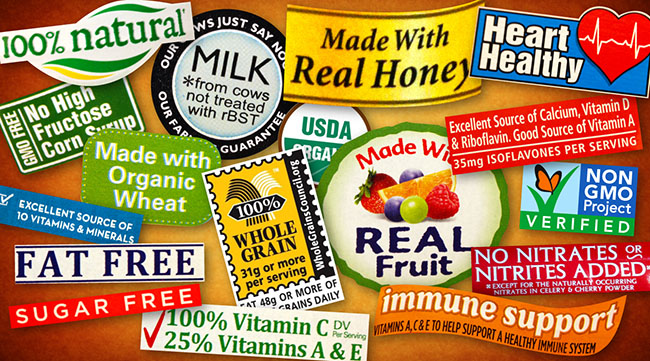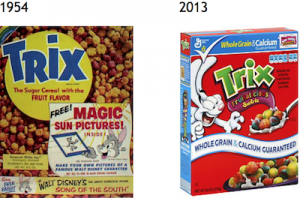In 1954, General Mills introduced Trix, a new children’s breakfast cereal whose berry-colored pebbles were advertised as “the sugar cereal with the FRUIT FLAVOR.” Now, in 2013, after a nutritional makeover, Trix packaging boasts of “calcium” and “whole grain,” using a checkmark with a stylized wheat stalk to underscore the point. The ingredients, however, didn’t get the same makeover. Despite the health claims, Trix remains a “sugar cereal,” made not from wheat, but corn, a less nutritious grain.
Health-related marketing is not limited to cereals: Snyder’s sells organic pretzels that contain beneficial omega 3 fatty acids; Lunchables Pizza touts the whole grain in its crusts; Campbell’s SpaghettiOs is billed as a good source of protein and 8 essential vitamins and minerals. The Oreo-look-a-like WhoKnew Smart Cookies proudly advertise fiber, whole grain, and “as much calcium as an 8 oz. glass of milk.” According to their package, the chocolate cookies are “filled with good stuff,” and “never this stuff”: no artificial colors, flavors, or preservatives; no hydrogenated oils, no high fructose corn syrup, and no trans-fat. What the package neglects to say is that WhoKnew still contains plenty of this stuff: calories, sugar, and fat.
Why should we be concerned about these health claims? Because product packaging advertising influences consumer perception and behavior. Studies have shown that health claims on products can affect what people buy, how much they eat, and how full they feel afterward. One study even found that color matters: green calorie labels that routinely appeared on candy were found to increase the perceived healthfulness of the product. Health-related marketing can create a “health halo” around unhealthy foods, making people think that what they are eating is more nutritious than it really is. But more than that, it gives companies an easy way out – instead of reformulating their products to be healthier overall, or marketing genuinely nutritious items, food companies can simply add Vitamin A to Frosted Hot Fudge Sundae PopTarts and call them a balanced breakfast food. The implications are especially concerning because many of these foods are routinely marketed to and eaten by children, a group that is particularly vulnerable to marketing.
It’s encouraging to see growing consumer demand for healthier foods—now we just need industry to see that fiber-enriched Froot Loops aren’t quite what we have in mind.
IMAGE SOURCE: Front of Package Labels. Digital image.Http://pickyeaterblog.com/demystifying-health-food-labels-what-do-they-all-mean/. The Picky Eater, 26 Feb. 2014. Web. 8 Dec. 2014.


